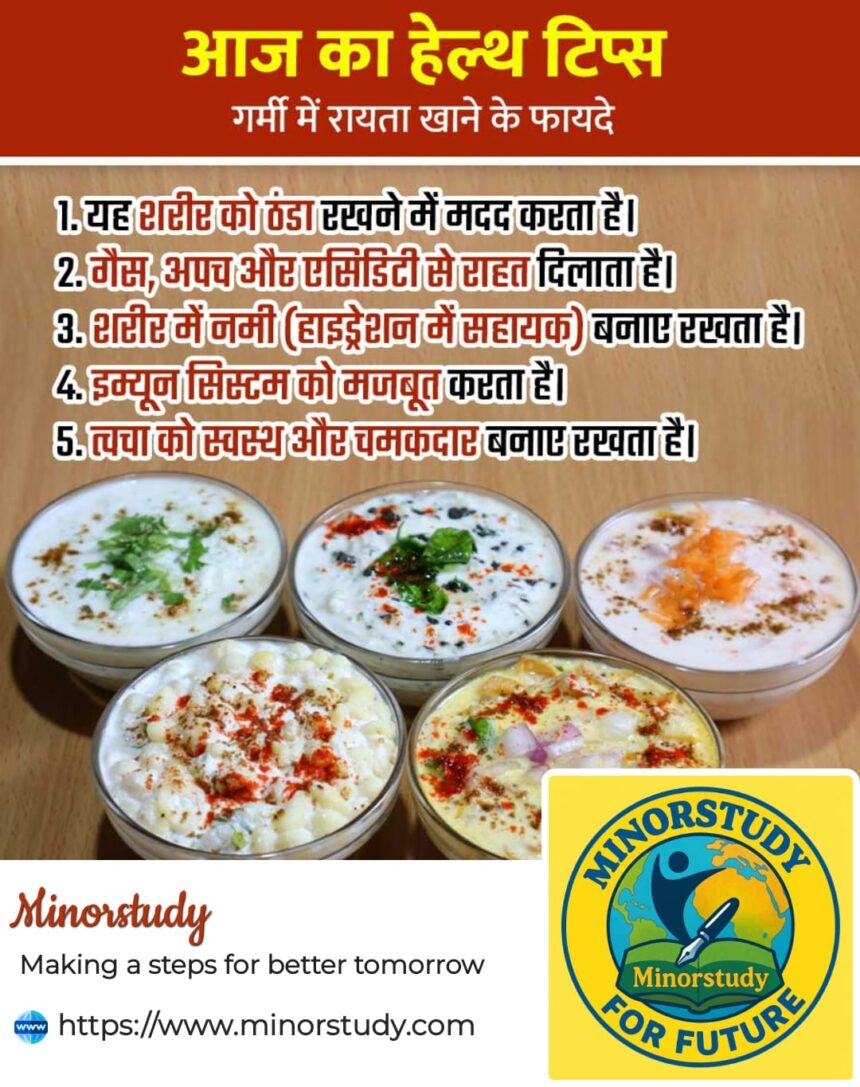🥣 Introduction: Raita – More Than Just a Side Dish
Raita: When the scorching Indian summer sets in, our bodies crave cool, hydrating, and digestion-friendly foods. Enter raita—a traditional Indian side dish made of curd (yogurt) mixed with vegetables, fruits, herbs, and spices. It’s not just a condiment, but a cooling companion that plays a significant role in our nutrition, digestion, and temperature regulation—especially in the summer months.
- 📜 History of Raita: A Cooling Legacy from Ancient Kitchens
- 📅 Timeline: Raita Through the Ages
- 🔥 Why Raita Is a Summer Superfood
- ✅ 9 Refreshing Benefits of Eating Raita in Summer
- 1. 🧊 Naturally Cools the Body
- 2. 🌿 Aids Digestion & Prevents Acidity
- 3. 💧 Keeps You Hydrated
- 4. 💪 Packed with Probiotics for Gut Health
- 5. 🌈 Versatile and Nutritious
- 6. 🍛 Enhances Taste and Prevents Overeating
- 7. ❤️ Good for Skin and Hair
- 8. 🍽 Helps with Weight Management
- 9. 👶 Safe and Nourishing for Kids and Elders
- 🧠 Interesting Facts About Raita
- ❓ FAQs About Eating Raita in Summer
- Q1: Can raita be eaten every day in summer?
- Q2: Can lactose-intolerant people eat raita?
- Q3: What is the best raita for extreme heat?
- Q4: Can raita help with heat strokes?
- Q5: Can raita be made vegan?
- 🎊 Cultural Observance and Practices
- 💬 Wishing You a Delicious and Cool Summer!
- 🌍 Importance in Daily Life and Society
- 📌 Key Points at a Glance
- 🧾 Conclusion: Bring Back the Raita Tradition
Often overlooked in modern diets, raita is an age-old solution to modern summer woes—from acidity and heat strokes to fatigue and indigestion. Let’s dive into the complete picture of raita’s benefits, its cultural roots, fascinating facts, and why it deserves a permanent place on your summer plate.
📜 History of Raita: A Cooling Legacy from Ancient Kitchens
The origins of raita can be traced back to Ayurvedic and Vedic India, where curd (dahi) was considered a divine food—offering both nutritional value and medicinal benefits.
In Ayurveda, raita was crafted with cooling ingredients like cucumber, mint, and coriander to balance pitta dosha, which increases during summer.
The term “raita” finds its root in Sanskrit—where “rajika” means mustard and “tiktaka” means bitter herbs, often used in early versions of the dish.
In ancient texts, curd mixed with herbs was recommended to aid digestion, especially after heavy or spicy meals.
Over centuries, raita evolved regionally—from the spicy boondi raita of North India to the sweet-fruit variants in South India, but its core purpose remains the same: cool the body, balance digestion, and enhance taste.
📅 Timeline: Raita Through the Ages
| Time Period | Milestone |
|---|---|
| 2000 BCE – Vedic Age | Raita-like curd preparations mentioned in Ayurvedic diets |
| 6th Century CE | Use of yogurt in Persian and Indian medicinal cuisine |
| Medieval India | Raita evolved as a staple side dish in royal kitchens |
| Mughal Era | Enhanced with saffron, dry fruits, and cooling spices |
| 21st Century | Recognized globally for its probiotic and cooling benefits |
🔥 Why Raita Is a Summer Superfood
The Indian summer brings with it:
Dehydration
Acid reflux
Loss of appetite
Excessive sweating
Digestive sluggishness
Raita directly counters these problems with:
Hydrating curd
Water-rich vegetables like cucumber, tomato, and onion
Cooling herbs like mint and coriander
Digestive spices like cumin and black salt
✅ 9 Refreshing Benefits of Eating Raita in Summer
Let’s break down the powerful benefits of this humble yet magical dish:
1. 🧊 Naturally Cools the Body
Curd is inherently cooling, reducing internal heat generated due to rising pitta dosha. When combined with mint, cucumber, or coriander, it forms a natural body coolant.
2. 🌿 Aids Digestion & Prevents Acidity
Spices like roasted cumin seeds, black pepper, and rock salt used in raita improve enzyme activity and soothe stomach lining, thus reducing bloating, acidity, and indigestion.
3. 💧 Keeps You Hydrated
Curd contains about 85–88% water, making raita a hydrating food. Add veggies like cucumber, tomatoes, or beetroot, and you’ve got a double dose of hydration.
4. 💪 Packed with Probiotics for Gut Health
Raita is rich in good bacteria (lactobacillus) that maintain gut flora, prevent infections, and boost nutrient absorption—especially helpful during monsoon-summer overlaps.
5. 🌈 Versatile and Nutritious
Raita can be tailored to your needs:
Cucumber raita: Great for cooling and detox
Boondi raita: Crunchy and satisfying
Pineapple raita: Adds sweetness and vitamin C
Beetroot raita: Packed with iron and antioxidants
6. 🍛 Enhances Taste and Prevents Overeating
Raita’s tangy, spiced flavour helps curb overeating of oily or spicy foods by satisfying the palate and balancing taste.
7. ❤️ Good for Skin and Hair
Probiotics, vitamin B12, and antioxidants in curd nourish skin and hair from within, combating summer breakouts, dullness, and hair fall.
8. 🍽 Helps with Weight Management
Raita is low in calories, high in protein and fiber (if you add veggies), and keeps you full—making it great for weight loss diets.
9. 👶 Safe and Nourishing for Kids and Elders
It’s soft, easy to digest, flavorful, and naturally rich in calcium and good fats—ideal for children and elders who are vulnerable to heat-related illnesses.
🧠 Interesting Facts About Raita
“Raita” is not just Indian; variations exist in Middle Eastern cuisines (like tzatziki).
In Ayurveda, curd is never consumed at night—but raita during lunch is recommended.
Beetroot and mint raita are often used in detox diets.
The lactic acid in curd acts as a natural bleach for skin—internal consumption also improves skin texture.
In ancient Indian households, curd was set daily at home—a living symbol of health.
❓ FAQs About Eating Raita in Summer
Q1: Can raita be eaten every day in summer?
Yes, raita is safe for daily consumption during the day. It’s best enjoyed at lunch to cool the digestive system.
Q2: Can lactose-intolerant people eat raita?
People with mild lactose intolerance often tolerate curd better than milk, as fermentation breaks down lactose. But individual sensitivity may vary.
Q3: What is the best raita for extreme heat?
Mint-cucumber raita is the best—both ingredients have natural cooling properties.
Q4: Can raita help with heat strokes?
While raita is not a cure, it helps maintain hydration and core body temperature, reducing the risk of heatstroke.
Q5: Can raita be made vegan?
Yes! Use plant-based curd made from almond, soy, or coconut milk for a vegan version.
🎊 Cultural Observance and Practices
In India, raita is not just food—it’s tradition.
In South Indian households, curd-based dishes are the final course of lunch to cool the system.
In Ayurvedic Panchakarma routines, curd and raita are used to rebalance body heat.
In Punjabi cuisine, boondi or onion raita is an essential pairing with parathas.
During Navratri fasts, people consume fruit raitas to stay energized and cool.
💬 Wishing You a Delicious and Cool Summer!
“May your plate always have a bowl of raita this summer—keeping your body cool, your digestion smooth, and your smile wide.”
🌍 Importance in Daily Life and Society
Reduces dependency on carbonated or artificial cold drinks
Encourages local, seasonal ingredients
Keeps healthcare costs down by improving digestion and immunity naturally
Promotes gut-friendly habits in kids from a young age
Highlights traditional, sustainable dietary practices
📌 Key Points at a Glance
| Element | Highlight |
|---|---|
| Key Ingredient | Curd/Yogurt |
| Ideal Additions | Cucumber, mint, cumin, coriander |
| Daily Best Use | With lunch |
| Avoid During | Late night, if cold or asthmatic |
| Health Benefits | Cooling, probiotic, anti-acidic, hydrating |
| Cultural Role | Integral to Indian thali and seasonal health |
🧾 Conclusion: Bring Back the Raita Tradition
In a world that’s chasing cooling drinks in bottles and powders, let’s not forget the centuries-old comfort of a bowl of raita. Affordable, easy to make, incredibly nutritious, and deeply rooted in India’s food wisdom, raita is more than a dish—it’s a remedy, a ritual, and a revelation.
So, this summer, as the sun blazes overhead, let your plate shine too—with a spoonful of cool, probiotic-rich, health-loving raita.








